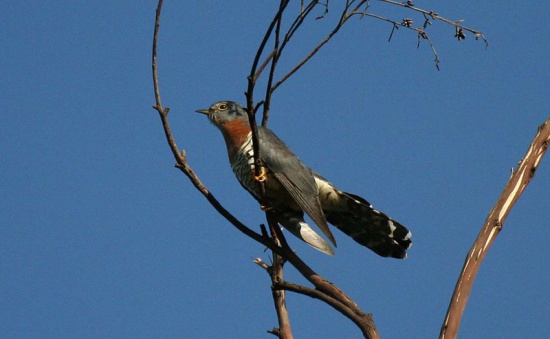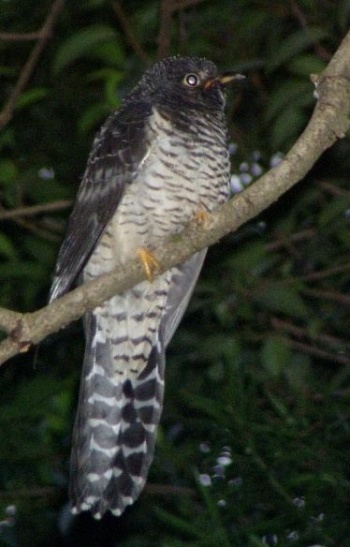(image of juvenile and genus link added) |
|||
| Line 20: | Line 20: | ||
Intra-African migrant. Usually solitary; calls frequently in breeding season, but otherwise inconspicuous. Diet: Invertebrates (mainly hairy caterpillars), small frogs and lizards, fruit and eggs. Feeds mainly in canopy. | Intra-African migrant. Usually solitary; calls frequently in breeding season, but otherwise inconspicuous. Diet: Invertebrates (mainly hairy caterpillars), small frogs and lizards, fruit and eggs. Feeds mainly in canopy. | ||
| − | '''Breeding''': A brood parasite | + | '''Breeding''': A brood parasite; the hosts are mainly Robin-Chats and Thrushes, the most common hosts in southern Africa being [[Cape Robin Chat]], [[Cape Wagtail]], and [[White-throated Robin Chat]]. Its eggs are brown and it can lay 20 eggs in a season in different nests. |
==References== | ==References== | ||
Revision as of 14:00, 30 March 2008
- Cuculus solitarius
Identification
Length 28-30 cm; mass 67-90 g; males generally larger than females.
Adult: Dark grey head and back, rufous chest. The eye is brown, the bill black, and the legs yellow. Rufous breast with grey chin and throat diagnostic. Back darker than Common Cuckoo and African Cuckoo and paler than western form of Black Cuckoo.
Juvenile: Lacks the rufous breast of the adult; upper parts, throat and breast almost black.
Voice: The characteristic three-note 'piet-my-vrou' call of the male is diagnostic; the females call 'pipipipipi'.
Distribution
Much of sub-Saharan Africa; absent from the most arid areas.
Taxonomy
Monotypic.
Habitat
Forest, closed woodland, plantations, clumps of trees, wooded gardens and parks.
Behaviour
Intra-African migrant. Usually solitary; calls frequently in breeding season, but otherwise inconspicuous. Diet: Invertebrates (mainly hairy caterpillars), small frogs and lizards, fruit and eggs. Feeds mainly in canopy.
Breeding: A brood parasite; the hosts are mainly Robin-Chats and Thrushes, the most common hosts in southern Africa being Cape Robin Chat, Cape Wagtail, and White-throated Robin Chat. Its eggs are brown and it can lay 20 eggs in a season in different nests.
References
Hockey PAR, Dean WRJ & Ryan PG (eds) 2005. Robert's Birds of Southern Africa, 7th edition. John Voelcker Bird Book Fund, Cape Town, South Africa. ISBN 0620340533





